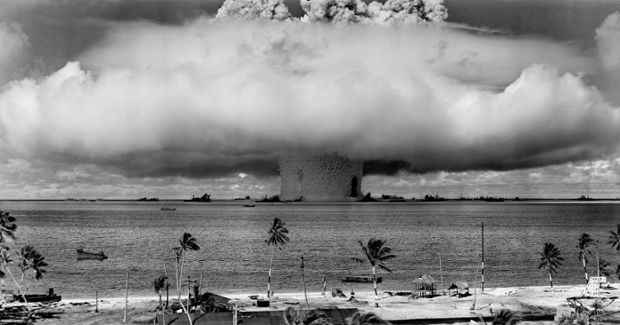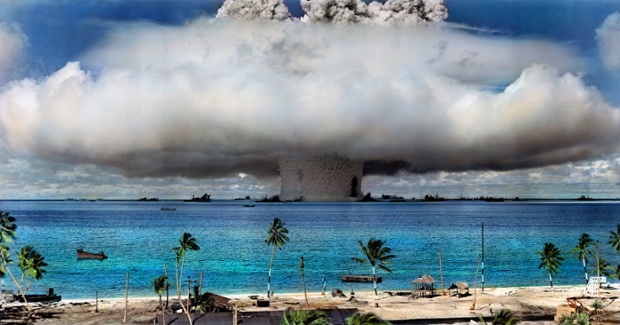
[div class=attrib]From the New York Times:[end-div]
For the French Fauvist painter and color gourmand Raoul Dufy, blue was the only color with enough strength of character to remain blue “in all its tones.” Darkened red looks brown and whitened red turns pink, Dufy said, while yellow blackens with shading and fades away in the light. But blue can be brightened or dimmed, the artist said, and “it will always stay blue.”
Scientists, too, have lately been bullish on blue, captivated by its optical purity, complexity and metaphorical fluency. They’re exploring the physics and chemistry of blueness in nature, the evolution of blue ornaments and blue come-ons, and the sheer brazenness of being blue when most earthly life forms opt for earthy raiments of beige, ruddy or taupe.
One research team recently reported the structural analysis of a small, dazzlingly blue fruit from the African Pollia condensata plant that may well be the brightest terrestrial object in nature. Another group working in the central Congo basin announced the discovery of a new species of monkey, a rare event in mammalogy. Rarer still is the noteworthiest trait of the monkey, called the lesula: a patch of brilliant blue skin on the male’s buttocks and scrotal area that stands out from the surrounding fur like neon underpants.
Still other researchers are tracing the history of blue pigments in human culture, and the role those pigments have played in shaping our notions of virtue, authority, divinity and social class. “Blue pigments played an outstanding role in human development,” said Heinz Berke, an emeritus professor of chemistry at the University of Zurich. For some cultures, he said, they were as valuable as gold.
As a raft of surveys has shown, blue love is a global affair. Ask people their favorite color, and in most parts of the world roughly half will say blue, a figure three to four times the support accorded common second-place finishers like purple or green. Just one in six Americans is blue-eyed, but nearly one in two consider blue the prettiest eye color, which could be why some 50 percent of tinted contact lenses sold are the kind that make your brown eyes blue.
Sick children like their caretakers in blue: A recent study at the Cleveland Clinic found that young patients preferred nurses wearing blue uniforms to those in white or yellow. And am I the only person in the United States who doesn’t own a single pair of those permanently popular pants formerly known as dungarees?
“For Americans, bluejeans have a special connotation because of their association with the Old West and rugged individualism,” said Steven Bleicher, author of “Contemporary Color: Theory and Use.” The jeans take their John Wayne reputation seriously. “Because the indigo dye fades during washing, everyone’s blue becomes uniquely different,” said Dr. Bleicher, a professor of visual arts at Coastal Carolina University. “They’re your bluejeans.”
According to psychologists who explore the complex interplay of color, mood and behavior, blue’s basic emotional valence is calmness and open-endedness, in contrast to the aggressive specificity associated with red. Blue is sea and sky, a pocket-size vacation.
In a study that appeared in the journal Perceptual & Motor Skills, researchers at Aichi University in Japan found that subjects who performed a lengthy video game exercise while sitting next to a blue partition reported feeling less fatigued and claustrophobic, and displayed a more regular heart beat pattern, than did people who sat by red or yellow partitions.
In the journal Science, researchers at the University of British Columbia described their study of how computer screen color affected participants’ ability to solve either creative problems — for example, determining the word that best unifies the terms “shelf,” “read” and “end” (answer: book) — or detail-oriented tasks like copy editing. The researchers found that blue screens were superior to red or white backgrounds at enhancing creativity, while red screens worked best for accuracy tasks. Interestingly, when participants were asked to predict which screen color would improve performance on the two categories of problems, big majorities deemed blue the ideal desktop setting for both.
But skies have their limits, and blue can also imply coldness, sorrow and death. On learning of a good friend’s suicide in 1901, Pablo Picasso fell into a severe depression, and he began painting images of beggars, drunks, the poor and the halt, all famously rendered in a palette of blue.
The provenance of using “the blues” to mean sadness isn’t clear, but L. Elizabeth Crawford, a professor of psychology at the University of Richmond in Virginia, suggested that the association arose from the look of the body when it’s in a low energy, low oxygen state. “The lips turn blue, there’s a blue pallor to the complexion,” she said. “It’s the opposite of the warm flushing of the skin that we associate with love, kindness and affection.”
Blue is also known to suppress the appetite, possibly as an adaptation against eating rotten meat, which can have a bluish tinge. “If you’re on a diet, my advice is, take the white bulb out of the refrigerator and put in a blue one instead,” Dr. Bleicher said. “A blue glow makes food look very unappetizing.”
[div class=attrib]Read the entire article following the jump.[end-div]
[div class=attrib]Image: Morpho didius, dorsal view of male butterfly. Courtesy of Wikipedia.[end-div]



 Please forget Instagram, Photoshop filters, redeye elimination, automatic camera shake reduction systems and high dynamic range apps. If you’re a true photographer or simply a lover of great photography the choice is much simpler: black and white or color.
Please forget Instagram, Photoshop filters, redeye elimination, automatic camera shake reduction systems and high dynamic range apps. If you’re a true photographer or simply a lover of great photography the choice is much simpler: black and white or color.
